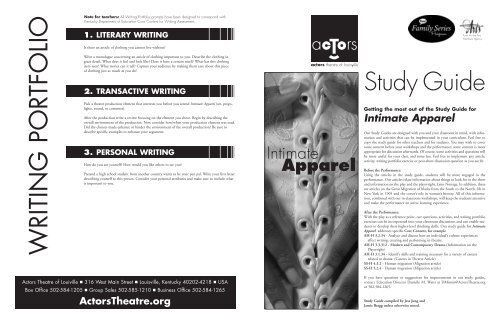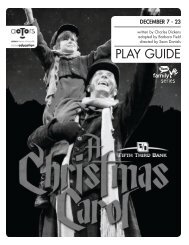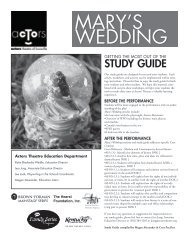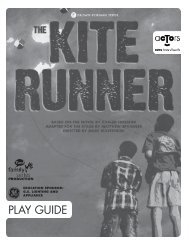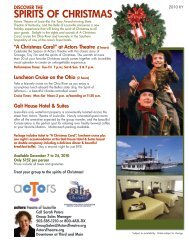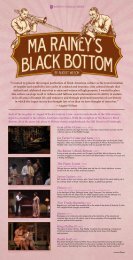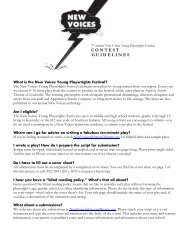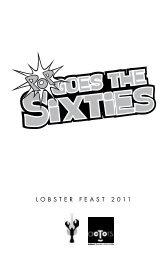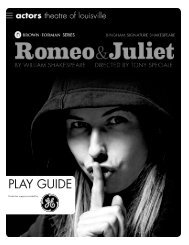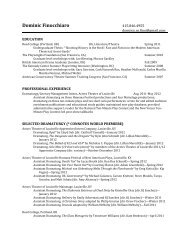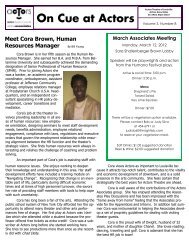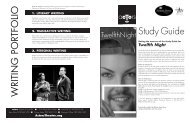Intimate Apparel Play Guide - Actors Theatre of Louisville
Intimate Apparel Play Guide - Actors Theatre of Louisville
Intimate Apparel Play Guide - Actors Theatre of Louisville
You also want an ePaper? Increase the reach of your titles
YUMPU automatically turns print PDFs into web optimized ePapers that Google loves.
WRITING PORTFOLIO<br />
Note for teachers: All Writing Portfolio prompts have been designed to correspond with<br />
Kentucky Department <strong>of</strong> Education Core Content for Writing Assessment.<br />
1. LITERARY WRITING<br />
Is there an article <strong>of</strong> clothing you cannot live without?<br />
Write a monologue concerning an article <strong>of</strong> clothing important to you. Describe the clothing in<br />
great detail. What does it feel and look like? Does it have a certain smell? What has this clothing<br />
item seen? What stories can it tell? Capture your audience by making them care about this piece<br />
<strong>of</strong> clothing just as much as you do!<br />
2. TRANSACTIVE WRITING<br />
Pick a theatre production element that interests you before you attend <strong>Intimate</strong> <strong>Apparel</strong> (set, props,<br />
lights, sound, or costumes).<br />
After the production write a review focusing on the element you chose. Begin by describing the<br />
overall environment <strong>of</strong> the production. Now consider how/when your production element was used.<br />
Did the choices made enhance or hinder the environment <strong>of</strong> the overall production? Be sure to<br />
describe specific examples to enhance your argument.<br />
3. PERSONAL WRITING<br />
How do you see yourself? How would you like others to see you?<br />
Pretend a high school student from another country wants to be your pen pal. Write your first letter<br />
describing yourself to this person. Consider your personal attributes and make sure to include what<br />
is important to you.<br />
<strong>Intimate</strong><br />
<strong>Apparel</strong><br />
Fund for the Arts<br />
Members Agency<br />
Study <strong>Guide</strong><br />
Getting the most out <strong>of</strong> the Study <strong>Guide</strong> for<br />
<strong>Intimate</strong> <strong>Apparel</strong><br />
Our Study <strong>Guide</strong>s are designed with you and your classroom in mind, with information<br />
and activities that can be implemented in your curriculum. Feel free to<br />
copy the study guide for other teachers and for students. You may wish to cover<br />
some content before your workshops and the performance; some content is more<br />
appropriate for discussion afterwards. Of course, some activities and questions will<br />
be more useful for your class, and some less. Feel free to implement any article,<br />
activity, writing portfolio exercise or post-show discussion question as you see fit.<br />
Before the Performance:<br />
Using the articles in the study guide, students will be more engaged in the<br />
performance. Our articles relate information about things to look for in the show<br />
and information on the play and the playwright, Lynn Nottage. In addition, there<br />
are articles on the Great Migration <strong>of</strong> blacks from the South to the North, life in<br />
New York in 1905 and the corset’s role in women’s history. All <strong>of</strong> this information,<br />
combined with our in-classroom workshops, will keep the students attentive<br />
and make the performance an active learning experience.<br />
After the Performance:<br />
With the play as a reference point, our questions, activities, and writing portfolio<br />
exercises can be incorporated into your classroom discussions and can enable students<br />
to develop their higher-level thinking skills. Our study guide for <strong>Intimate</strong><br />
<strong>Apparel</strong> addresses specific Core Content, for example<br />
AH-H 3.2.34 - Analyze and discuss how an individual’s culture experiences<br />
affect writing, creating and performing in theatre.<br />
AH-H 3.3.312 - Modern and Contemporary Drama-(Information on the<br />
<strong>Play</strong>wright)<br />
AH-H 3.1.34 - Identify skills and training necessary for a variety <strong>of</strong> careers<br />
related to drama. (Careers in <strong>Theatre</strong> Article)<br />
SS-H 4.3.2 - Human migration (Migration article)<br />
SS-H 5.2.4 - Human migration (Migration article)<br />
<strong>Actors</strong> <strong>Theatre</strong> <strong>of</strong> Louiville ■ 316 West Main Street ■ <strong>Louisville</strong>, Kentucky 40202-4218 ■ USA<br />
Box Office 502-584-1205 ■ Group Sales 502-585-1210 ■ Business Office 502-584-1265<br />
<strong>Actors</strong><strong>Theatre</strong>.org<br />
If you have questions or suggestions for improvements in our study guides,<br />
contact Education Director Danielle M. Watts at DMinnis@<strong>Actors</strong><strong>Theatre</strong>.org<br />
or 502-584-1265.<br />
Study <strong>Guide</strong> compiled by Jess Jung and<br />
Jamie Bragg unless otherwise noted.
<strong>Play</strong><br />
Synopsis<br />
In 1905 Manhattan, Esther Mills sews beautiful corsets for a living. Her<br />
art and talent have earned her economic independence rare for an<br />
unmarried woman <strong>of</strong> color and allows her access to diverse social<br />
worlds. In segmented Victorian New York, a black prostitute, a white<br />
millionaire matron and an Orthodox Jewish merchant would never<br />
meet, but through her work Esther befriends all three. Prostitute<br />
Mayme and Esther both enjoy financial independence, but Mayme’s<br />
race, class, and pr<strong>of</strong>ession prevent her from becoming a concert pianist.<br />
Society matron Mrs. Van Buren will lose her privileged life if she leaves<br />
her loveless marriage. Fabric merchant Mr. Marks must choose between<br />
his faith and his romantic attraction to Esther.<br />
Panama Canal<br />
Approximately 800,000 ships have<br />
passed through the Panama Canal since<br />
its completion in 1914. Fifty-one miles in<br />
length, the canal’s path pushes through<br />
Central America’s Isthmus <strong>of</strong> Panama,<br />
connecting the Atlantic and Pacific<br />
Oceans. Its construction was a long,<br />
dangerous process plagued by fatal<br />
landslides and disease. However, the<br />
canal’s completion is celebrated as one<br />
the most successful engineering feats in<br />
history. A ship sailing from the East to<br />
the West coast <strong>of</strong> the United States will<br />
save over 13,000 miles!<br />
At thirty-five Esther has no suitors, but yearns for physical and emotional<br />
intimacy. Her landlady, Mrs. Dickson, urges Esther to marry<br />
respectably, but the seamstress corresponds with George Armstrong, a<br />
Barbadian laborer who is helping build the Panama Canal. Esther, illiterate,<br />
asks her clients to write in her stead, and as the correspondence<br />
grows more passionate, George proposes to Esther and moves to New<br />
York to marry her. But each has misled the other, and both are disappointed<br />
by the person they’ve married. Race and immigrant bias prevent<br />
George from finding work, and he struggles with his role <strong>of</strong> provider.<br />
Desperate, he asks Esther for her entire savings. He gambles away the<br />
money and abandons her. Esther moves back to the boarding house and<br />
begins to rebuild her dreams.<br />
Cast <strong>of</strong> Characters:<br />
Esther Mills 35, African American seamstress<br />
Mrs. Dickson 50, African American proprietor<br />
<strong>of</strong> boarding house for unmarried women<br />
Mrs. Van Buren 30s, white wealthy socialite<br />
Mr. Marks 30s, Romanian Jewish immigrant,<br />
textile merchant<br />
Post-Show<br />
Discussion Questions<br />
The idea that there is something wrong with a woman if she<br />
is not married resonates throughout <strong>Intimate</strong> <strong>Apparel</strong>.<br />
Consider Ester, Mrs. Van Buren, and Mayme. How do each<br />
<strong>of</strong> these women either accept or reject this idea? Is this opinion<br />
still relevant in today’s society?<br />
At the end <strong>of</strong> the play Ester is left alone smiling at her sewing<br />
machine. Why is this image important? What do you think<br />
Ester’s future holds?<br />
Mayme 30s, African American prostitute and<br />
dance hall performer<br />
George 30s, black laborer from Barbados<br />
Top: Spirella factory floor, 1910.<br />
Opened in 1909, the workforce<br />
consisted entirely <strong>of</strong> women.<br />
Above: Wedding corset, 1905.
CAREERS IN THEATRE<br />
Margret Fenske, Costume Shop Manager<br />
Margret Fenske, <strong>Actors</strong> <strong>Theatre</strong>’s Costume Shop Manager,<br />
surfaced from a sea <strong>of</strong> petticoats and overcoats to share<br />
memories <strong>of</strong> her many years <strong>of</strong> costuming, and particularly<br />
<strong>of</strong> her nine years at <strong>Actors</strong>.<br />
Margret found a passion for costuming at an early age. At<br />
seven years old, she entered a series <strong>of</strong> contests to design<br />
clothes for characters in a favorite comic strip, and she<br />
won several times. Her mother, a gifted seamstress,<br />
encouraged Margret to play with fabric left over from<br />
sewing projects.<br />
Margret still loves playing with fabric. Though she spends<br />
much <strong>of</strong> her day ordering supplies and recording purchases,<br />
she particularly enjoys costume construction. Margret<br />
is a draper, the person who brings to life the designer’s<br />
ideas. The designer decides what colors, textures, and<br />
shapes will clearly communicate the director’s interpretation<br />
<strong>of</strong> the play. The designer then draws the costume and<br />
gives that drawing, called a rendering, to the draper. The<br />
draper studies this rendering and recreates the design<br />
three-dimensionally by arranging cloth around a mannequin,<br />
gathering and pinning the material into the<br />
desired shape. This shape, known as the mock-up, is the<br />
draft for the final costume. The draper marks each pleat<br />
and dart with a laundry pen or tape, and then unpins the<br />
fabric, removing it from the mannequin and laying it flat<br />
on the table. <strong>Guide</strong>d by the marks on the fabric the draper<br />
cuts the pattern for the actual costume. Draping is challenging;<br />
the mock-up must not only visually recreate the<br />
rendering, it must be a functioning garment that allows<br />
the actor full physical expression.<br />
Costumers prefer the term “building” to “sewing.”<br />
Margret says the substitution cuts to the heart <strong>of</strong> her<br />
work: “There’s a lot more artistry in bringing something<br />
to life from the ground up than going out to the mall,<br />
buying a dress, and changing the hem or sleeves. The eyes<br />
light up when it’s a build; there’s more input, more things<br />
people get to do to make it special.” Margret relishes especially<br />
challenging builds; among her favorite historical<br />
fashions are the “intricate carved sleeves” <strong>of</strong> the 1830’s;<br />
“the patterns are just wild,” Margret says, and she loves<br />
“the challenge <strong>of</strong> figuring out how they did what they did<br />
. . . doing the research and finding out how it was done in<br />
the first place.”<br />
This season’s production <strong>of</strong> <strong>Intimate</strong> <strong>Apparel</strong> brings the<br />
sewing machine from costume shop to stage. Like<br />
Margret, for protagonist Esther Mills sewing is both the<br />
source <strong>of</strong> her income and her art. <strong>Play</strong>wright Lynn<br />
Nottage makes tailoring and corsetry central metaphors,<br />
and describes Esther’s beloved fabrics in sensual detail.<br />
Margret is delighted to be working on a production that<br />
so thoughtfully explores her craft, and the stitchers and<br />
designers have been talking about <strong>Intimate</strong> <strong>Apparel</strong> “since<br />
the beginning <strong>of</strong> the year.” The shop is busy browsing specialty<br />
catalogs and Internet sites for delightful relics like<br />
spoon busks (curved pieces <strong>of</strong> wood or whalebone slotted<br />
into the bodice to keep the back straight). Margret is<br />
always excited when the fabric and trim orders arrive. “It’s<br />
like Christmas! But all the stuff has to be inventoried . . .<br />
so it’s a little while before we get to play.”<br />
#15 from The Migration Series<br />
Another cause was lynching. It was found that where there had<br />
been a lynching, the people who were reluctant to leave at first<br />
left immediately after this.<br />
’<br />
New York City, 1908
A New York Evolution<br />
A little elbow grease can transform a person from rags to riches. This<br />
“American Dream” gained traction at the turn <strong>of</strong> the 20 th century when<br />
industrial innovations generated thousands <strong>of</strong> new jobs. People from<br />
around the world left their homes to take part in massive new commercial<br />
and retail industries in the United States. Their first stop: New York<br />
City.<br />
Many “old” New Yorkers were frightened <strong>of</strong> these vast changes. School<br />
became the target institution in which to enforce traditional American<br />
ideals. By 1909 70% <strong>of</strong> NYC’s schoolchildren had been born abroad.<br />
The public school system was determined to Americanize immigrant<br />
children through steady doses <strong>of</strong> American history, manners, and<br />
hygiene. New York School Superintendent William H. Maxwell:<br />
The mass market originated in 1901 when Charles Schwab and J.P.<br />
Morgan combined their small steel companies to create the US Steel<br />
Corporation. Steel companies that had previously competed individually<br />
for business now united creating an oligopoly dominating the steel<br />
market. As a proven catalyst for economic growth, consolidation became<br />
a prudent and popular business venture. When the electrical current<br />
replaced steam belts in factories, mechanical production increased exponentially.<br />
As the market grew, the assembly line was born, and thousands<br />
<strong>of</strong> new jobs were waiting to be filled by eager immigrants.<br />
“[The New York Public School System] is the melting pot which converts the<br />
children <strong>of</strong> immigrants…into sturdy, independent American citizens.”<br />
Fresh industry also altered the shape <strong>of</strong> New York. Instead <strong>of</strong> buying<br />
goods at small private markets, New Yorkers swarmed newly fabricated<br />
department stores. Additionally, steel frame construction and the elevator<br />
(invented in 1853 by Elisha Graves) paved the way for the skyscraper.<br />
The former New York skyline, peaked with the spires <strong>of</strong> Gothic style<br />
Cathedrals, was now dominated by tall corporate edifices.<br />
Between 1900 and 1915 fifteen million immigrants flooded into the city.<br />
They were from Germany, Ireland, Italy, Greece, Poland, Russia,<br />
Hungary, Turkey, and more. Richard Williams <strong>of</strong> the Wall Street Journal<br />
wrote:<br />
“The Flood gates are open. The dam is washed away. The sewer is unchoked.<br />
Europe is vomiting.”<br />
By 1900 Manhattan’s heaving city blocks were the most populated in the<br />
world. Most immigrants lived on the Lower East Side. Twenty or more<br />
bodies crammed into one-bedroom apartments. Children slept four to a<br />
bed while many adults were forced to sleep in shifts. However congested,<br />
many immigrants found comfort in their tight-knit communities.<br />
Pockets <strong>of</strong> foreign lands bustled within a new atmosphere:<br />
“Though I was in America, I lived in practically the same environment<br />
which we brought from home. Of course, there was a difference in our joys,<br />
in our sorrows, in our hardships … but on the whole we were still in our village.”<br />
— Rose Chen, Jewish Immigrant<br />
New York evolved. Millions <strong>of</strong> people and hundreds <strong>of</strong> cultures meshed<br />
together. New faces bubbled together. As the previous image <strong>of</strong> America<br />
faded and a new question surfaced: what is American?<br />
The first plan for the New York subway system was composed in 1900.<br />
7,700 immigrants, primarily <strong>of</strong> Irish and Italian decent, dug through<br />
their city’s soil to construct twenty plus miles <strong>of</strong> underground train tunnels.<br />
On October 27, 1904 the subway became the latest, greatest innovation<br />
in public transportation. Within the next four years one million<br />
New Yorkers were riding the subway per day.<br />
The combustion <strong>of</strong> new inventions, markets, and faces produced at the<br />
turn <strong>of</strong> the 20 th century was the forefront <strong>of</strong> the modern city. Power<br />
shifted, businesses boomed, thoughts combined, and new innovations in<br />
technology rocked the face <strong>of</strong> the United States. In short, the New York<br />
City familiar today was born.<br />
Terms<br />
Harlem Renaissance<br />
A great flourish <strong>of</strong> African American art,<br />
writing, and music that developed in<br />
Harlem, New York during the 1920’s.<br />
Also known as the “New Negro<br />
Movement.”<br />
Activity<br />
Visit the following website to view the<br />
“Migration Series”<br />
http://www.columbia.edu/itc/history/odonnell/w1010/<br />
edit/migration/migration.html<br />
Choose your favorite painting. Now pretend<br />
you can step into the artwork. Use<br />
your five senses to journal this experience.<br />
What do you see, hear, smell, taste, and<br />
feel? Where are you? Are their other characters<br />
in the scene? Who are they? Finally,<br />
take a moment to reflect on the images you<br />
encountered. What would it have been<br />
like to be a part <strong>of</strong> the Great Migration?<br />
#1 from The Migration Series<br />
During the World War there was a great migration North by Southern Negroes.
JACOB LAWRENCE<br />
Between 1890 and 1900 the black population <strong>of</strong> New York City tripled,<br />
between 1910 and 1920 the population increased another 66%, and<br />
between 1920 and 1930 it grew another whopping 115%. At the turn<br />
<strong>of</strong> the century, African Americans <strong>of</strong> the South left their jobs, homes,<br />
and sometimes families to find better opportunities in the North. Their<br />
journey has been dubbed the Great Migration and is a landmark in<br />
American history. Painter Jacob Lawrence captures the hope, struggle,<br />
and determination <strong>of</strong> this remarkable journey through his “Migration<br />
Series.”<br />
After the Civil War, the South became a dangerous place for its black residents.<br />
Although slavery had been abolished, discrimination continued<br />
to be a harsh fact <strong>of</strong> life. After WWI, the South was given control <strong>of</strong> its<br />
legal system. This control was greatly abused. Jim Crow Laws (established<br />
in 1880) segregated public spaces, including public transportation,<br />
bathrooms, and drinking fountains. More blacks were tortured<br />
and/or lynched during these years than any other time in history. In the<br />
North, industrial production soared and workers were needed to fill the<br />
assembly lines. Factory owners pointed towards the South for cheap<br />
labor. Many blacks saw the North as a grand land in which to create a<br />
better life. The great migration began. New hope swelled within communities<br />
and soon entire families left their homes to create another in<br />
the North. It wasn’t long, however, before harsh realities <strong>of</strong> this new environment<br />
set in…<br />
When I was home de<br />
Sunshine seemed like gold.<br />
When I was home de<br />
Sunshine seemed like gold.<br />
Since I cam North de<br />
While damn world’s turned cold.<br />
— “Po’ Boy Blues”, Langston Hughes, 1932<br />
Many Northerners felt threatened by their new neighbors. Black communities<br />
or neighborhoods formed within northern cities. Although safe<br />
within their communities, hatred still lurked outside. Being caught outside<br />
<strong>of</strong> one’s neighborhood at the wrong time <strong>of</strong> day could lead to fatal<br />
consequences. Protection by the police was a fleeting hope as many<br />
police <strong>of</strong>ficers were just as violent as their civilian compatriots.<br />
Factory work was also brutal. Long hours and unsanitary facilities <strong>of</strong>ten<br />
made work more dangerous than rewarding. Nevertheless, those who<br />
were employed were lucky. Industrial production produced a swell <strong>of</strong><br />
European immigrants looking for the same opportunities. Many black<br />
workers were displaced.<br />
Times were changing and as Northern cities found themselves in a state<br />
<strong>of</strong> flux, African Americans found themselves becoming further and further<br />
marginalized. Black culture was turned upside down. Black communities<br />
became airtight pouches filled with both the old and new<br />
visions <strong>of</strong> the African American. Southern mixed with Northern, rural<br />
with urban expelling dynamic new innovations in the arts.<br />
Born in 1917, Jacob Lawrence was younger than artists <strong>of</strong> the Harlem<br />
Renaissance. He was, however, greatly influenced by their contributions<br />
to Black American culture. He has been labeled an “expressive cubist”<br />
using strong, abstract form, delineated through strict lines and bold colors.<br />
His signature “Migration Series” captures the journey <strong>of</strong> the African<br />
American from the North to the South. Lawrence began work on the<br />
series untraditionally: not in his art studio, but in the library. There he<br />
researched the history <strong>of</strong> the Great Migration and composed a story told<br />
through a series <strong>of</strong> captions. Each caption was then used as inspiration<br />
to create the painting it accompanied. When the series was completed a<br />
year later, sixty paintings were displayed, depicting a story <strong>of</strong> great struggle<br />
and change.<br />
The story begins and ends in a train station. Fatigue is apparent among<br />
a dreary, crowded atmosphere. “The Railroad stations were at times so over<br />
packed with people leaving that special guards had to be called to keep order,”<br />
but, “…the migrants kept coming.” Lawrence uses a ladder and other<br />
means <strong>of</strong> vertical movement throughout the work. For example, one<br />
painting in the series is a dark, empty staircase. The flight is narrow,<br />
brown, bleak; it gives the viewer a sense <strong>of</strong> claustrophobia. However, a<br />
door at the top <strong>of</strong> the stairwell provides hope to another passage. In<br />
black tradition, a “ladder” represented progression. Here, Lawrence uses<br />
these images to link the past with the future — the North with the<br />
South. He courageously depicts the harsh realities <strong>of</strong> each environment,<br />
and by doing so, expresses the strength <strong>of</strong> the migrating generation. An<br />
event once overlooked in American history was exposed. It provoked a<br />
discussion <strong>of</strong> culture, class, and heritage — a discussion still relevant<br />
today.<br />
Viewing Jacob Lawrence’s “Migration Series” is not simply viewing a<br />
compilation <strong>of</strong> artworks. Instead, it is viewing a piece <strong>of</strong> American history…<br />
“Crossroads, bus stations, and train stations — moments <strong>of</strong> transition — it<br />
certainly was a moment <strong>of</strong> transition in the history <strong>of</strong> America and for the<br />
race … And I want to say this too: I don’t think the blacks in making a<br />
movement just contributed to their own development. It contributed to<br />
American development.”<br />
— Jacob Lawrence<br />
Terms<br />
Oligopoly<br />
A market dominated by a small number <strong>of</strong> businesses.<br />
Consolidation<br />
To become united into one whole.<br />
Melting Pot<br />
Term used to describe the process <strong>of</strong> different cultures blending<br />
together. It was first coined by Israel Zangwill’s play The Melting<br />
Pot (1908).<br />
Ideal<br />
A model <strong>of</strong> excellence.<br />
Steel Frame Construction<br />
Gave buildings a steel skeleton. This skeleton transferred the support<br />
<strong>of</strong> the building from the walls to the inner frame, making it possible<br />
to build multiple levels. Steel frame construction was first seen<br />
in Chicago and New York in the 1880s.<br />
Edifice<br />
A large building.<br />
Activity<br />
Find one unique quality regarding your heritage to share with your<br />
class. It could be a family recipe, historical event, family tradition,<br />
or ceremony…whatever interests you. Have pride in your family history!<br />
New York City, 1908
LYNN<br />
NOTTAGE<br />
Whether set in 1905 Manhattan, the court<br />
<strong>of</strong> Louis XIV, or post-colonial Mozambique,<br />
Lynn Nottage’s plays explore societal<br />
forces acting on communities: race and<br />
gender bias in <strong>Intimate</strong> <strong>Apparel</strong>, terrorism<br />
in The Por’ Knockers, post-colonial unrest in<br />
Mud, River, Stone and domestic violence<br />
in Po<strong>of</strong>! Her deeply sympathetic characters<br />
<strong>of</strong>ten come from broken communities and,<br />
in an effort to rebuild, they reach out to others<br />
unlike themselves, finding intimacy and<br />
support in relationships that cross ethnic<br />
and ideological barriers. Nottage holds<br />
degrees in writing from Brown and Yale<br />
Universities, but she contends that her journey<br />
as a playwright began at her mother’s<br />
kitchen table. Her childhood home in<br />
Brooklyn was filled with articulate, socially<br />
engaged women from many walks <strong>of</strong><br />
life—nurses, teachers, activists and artists.<br />
These women joined her mother and<br />
grandmother around the kitchen table, and<br />
she would listen to the stories they shared.<br />
She still lives in her Brooklyn childhood<br />
home, where she is raising her own family.<br />
And family stories continue to compel<br />
her: the original inspiration for <strong>Intimate</strong><br />
<strong>Apparel</strong> is the life <strong>of</strong> Nottage’s greatgrandmother,<br />
Ethel Boyce, a seamstress in<br />
turn-<strong>of</strong>-the-century New York who, like<br />
Esther, married a Barbadian immigrant she<br />
met through correspondence.<br />
Nottage writes plays, because unlike novelists<br />
or poets, in theatre collaboration is<br />
essential. The playwright’s words “get interpreted<br />
by a director, by actors, by designers<br />
and finally by an audience.” In this<br />
way her words are spoken through “the<br />
voice <strong>of</strong> many artists.” Her childhood love<br />
<strong>of</strong> conversation informs her writing and<br />
style <strong>of</strong> working now, and inspires her<br />
favorite description <strong>of</strong> her career: a playwright<br />
“skillfully introduces a topic at a<br />
dinner party. It’s fascinating to listen to how<br />
people respond to an idea, how they build<br />
upon it, deconstruct it, twist and turn it until<br />
it becomes their own.”<br />
Corset<br />
It’s easy to see why Lynn Nottage made<br />
corsetry a central metaphor for <strong>Intimate</strong><br />
<strong>Apparel</strong>. Throughout history, corsets have<br />
reflected cultural perceptions <strong>of</strong> body and identity.<br />
By reshaping the body the corset forms an<br />
alternative sense <strong>of</strong> self that the wearer presents<br />
to the world.<br />
The corset’s construction and function have<br />
varied widely over time. The first, worn by<br />
Renaissance aristocrats, provided a firm base<br />
for elaborate court fashions. Victorian corsets<br />
also supported clothing, but unlike their<br />
Renaissance counterparts, 19 th century corsets<br />
radically reshaped the body. Stiffened fabric<br />
was tailored to cinch the waist and give the illusion<br />
<strong>of</strong> larger breasts and buttocks. Further<br />
shaping the stiff fabric were stays, inserts <strong>of</strong><br />
bone or metal fitted into vertical slots that followed<br />
the curves <strong>of</strong> the corset. No woman<br />
could corset herself unassisted; her mother,<br />
husband, or maid laced the garment tight<br />
around the torso, molding the woman’s body<br />
into the desired hourglass shape. This figure,<br />
with the breasts and hips <strong>of</strong> a mother and the<br />
waist <strong>of</strong> a child, was the feminine ideal. Such a<br />
woman was both maternal and delicate; she<br />
nurtured children and was in turn protected by<br />
her husband.<br />
But as <strong>Intimate</strong> <strong>Apparel</strong> explores, corsets were<br />
not simplistic tools <strong>of</strong> the patriarchy. Many<br />
women embraced the corset as a means <strong>of</strong><br />
exploring identities outside <strong>of</strong> the narrow roles<br />
they were forced to play in real life. Like Mrs.<br />
Van Buren, many respectable society matrons<br />
wore revealing lingerie to feel “naughty,” to<br />
express forbidden sexual fantasies; Mrs. Van<br />
Buren enjoys that her corset makes her look<br />
like “a tart from the Tenderloin.” For other<br />
women, fashion satisfied fantasies <strong>of</strong> an<br />
empowered and graceful life. Prostitute Mayme<br />
wears her corset to look like a Fifth Avenue<br />
heiress; to her, a corset represents wealth, prestige,<br />
and respectability. Esther’s corsets enable<br />
Mayme to live in such a fantasy, and Esther<br />
dreams <strong>of</strong> a salon in which working class<br />
women will feel like ladies.<br />
However, while many used the corset as an<br />
escape from a limited societal role, others<br />
found corsets emblematic <strong>of</strong> the role itself.<br />
Because lower- and middle-class women could<br />
now afford cosmetic enhancements, these<br />
women were now held to standards <strong>of</strong> fashion<br />
that once applied only to the aristocracy. Their<br />
upper-class counterparts had servants to assist<br />
or completely manage household duties, leaving<br />
the aristocratic woman free to pursue fashion<br />
and other leisure activities. Lower- and<br />
middle-class women were expected to put on<br />
the identity <strong>of</strong> leisured ladies while still maintaining<br />
efficient households. Beauty became a<br />
wifely duty comparable to cooking and cleaning.<br />
In popular ladies’ magazines, matron<br />
columnists warned that a dowdy or prudish<br />
wife drives her husband to infidelity, and thus<br />
urged married readers to use lingerie as marriage<br />
aids. Though Mrs. Van Buren derives personal<br />
satisfaction from her lingerie, she also<br />
wears it to win emotional and physical intimacy<br />
with her increasingly distant husband.<br />
Esther does not wear lipstick and a revealing<br />
corset to fulfill her own sexual desires. Instead,<br />
she creates a false identity that she hopes will<br />
win George’s love.<br />
Though women still shape their bodies to conform<br />
to societal standards <strong>of</strong> beauty, Pilates and<br />
support hose have replaced lacing and stays. Yet<br />
the corset is still a potent symbol <strong>of</strong> sexual discovery<br />
and social repression; famously,<br />
Madonna has chosen to wear corsets to comments<br />
on these themes. Given the advances in<br />
fashion technology, the garments worn by the<br />
women in <strong>Intimate</strong> <strong>Apparel</strong> may seem archaic,<br />
but the corset’s role in shaping a woman’s identity<br />
remains strong.<br />
Jeunne fille au corset rose by Eugène Vidal<br />
Further Reading:<br />
Inventing the American Woman: A<br />
perspective on Women’s History<br />
1865 to the Present<br />
Glenda Riley<br />
The Corset<br />
Valerie Steele<br />
The Black New Yorkers: 400<br />
Years <strong>of</strong> African American History<br />
The Schomberg<br />
Illustrated Chronology<br />
A Tyranny <strong>of</strong> Change: America in<br />
the Progressive Era: 1890-1920<br />
John Whiteclay Chambers II<br />
A Very Different Age: Americans<br />
<strong>of</strong> the Progressive Era<br />
By Steven J. Diner<br />
Journey to Freedom: The African-<br />
American Great Migration<br />
By Maurice Isserman<br />
Jacob Lawrence: The Migration<br />
Series<br />
Introductory Essay<br />
by Henry Louis Gates


